

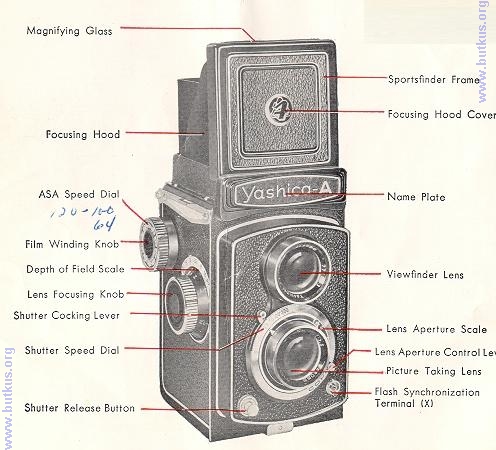
REMOVING THE CAMERA FROM THE CASE
TO remove the camera for film loading raise the two metal
Lock Slides.
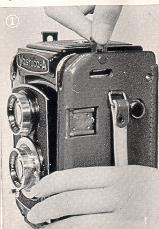 |
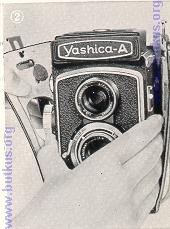 |
| Spread the sides of the case apart and lift
the camera free.4www.butkus.org
Just snap off the bottom when removing the entire front element of the carrying case. Your Yashica camera comes complete with a deluxe, leather eveready case. While the camera is in the case, all working parts are visible and ready to use. All you need to do is open the back-snap and lift the top of the case forward. |
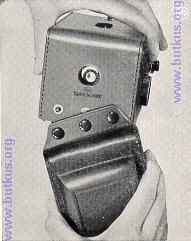 |
LOADING FILM
* 120 size film
* 12 pictures per roll in the popular 2 1/4 X 2 1/4 size
* Black-White or Color
(1)
To unlock back cover, turn the tripod socket in the direction marked '0'. Then
open the Back Cover by swinging it out.
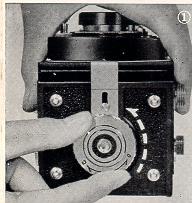 |
(2) Remove the Take-Up Spool in the Lower Film Chamber by pulling out the Lower Film Spool Locking Spring. (3) Place the Take-Up Spool in the Upper Film Chamber by pulling out the Upper Film Spool Locking Spring. (4) Place a new roll of size 120 film in the Lower Film Chamber. | |
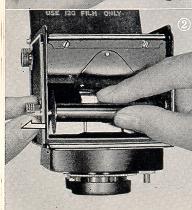 |
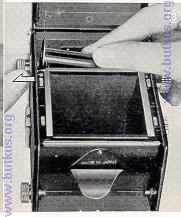 |
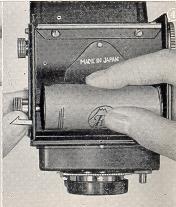 |
|
(5) Gently draw out the film leader. Thread the film leader into
the wider slot of the Take-Up Spool in the Upper Film Chamber, then turn
the Film Winding Knob. Make sure that the film leader is placed
evenly. |
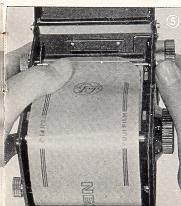 | |
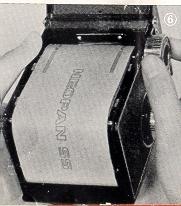 |
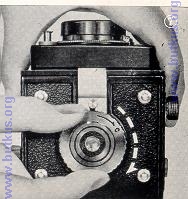 |
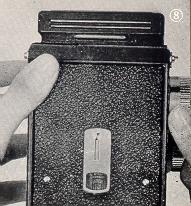 |
Caution: When loading or unloading film stand in a shadow-- never in
strong, direct sunlight.
PICTURE TAKING PROCEDURE
|
(1) Open the Viewfinder Hood by lifting it at back. Press the Viewfinder Hood down to close it. (2) Set the Lens Aperture Control Lever to the desired number on the Lens Aperture Scale. (3) Set the Shutter Speed Dial on the required speed to the Shutter Speed Indicator. (4) Push down the Shutter Cocking Lever. Be sure not to change Shutter Speed after the shutter is cocked. |
|
|
|
|
(5) Now gently release the Shutter by pressing the Shutter Release Button. |
|
MAGNIFYING GLASS |
Assures more accurate focusing (A) Raise the Magnifying Glass by pressing the front of the
Focusing Hood Cover inward. holding the Focusing Hood so that it does not
close.
|
|
|
|
SPORTS FINDER Sight your subject through the Sportsfinder Window. Push the Release Button when close it.
|
|
| TAKING FLASH PICTURES As you become more proficient at taking pictures, you will want to acquire accessories that increase the versatility of your Yashica. One of the first accessories you will want will be a flash unit. Your Yashica is ready and waiting. Synchronization for flash is built-in. A standard PC connector plugs into the flash terminal. Your camera dealer will be glad to supply the proper flash attachment for your camera. Your Yashica A offers X synchronization for short peak bulbs-- SM and SF--and for Electronic Flash. |
|
CABLE RELEASE A standard, overlap-tyupe Cable Release can be fitted to your Yashica. Simply unscrew the Shutter Release Ring and screw in the Cable Release. Your camera dealer will supply the proper Cable Release for your camera. |
|
|
To calculate exposures for flash pictures, follow the
bulbs manufacturers simple recommendations.
(Web master: Any automatic flash will work with this camera so long as it has a PC cord and handle. A handle can be purchased separately with hot-shot abilities.) 4www.butkus.org |
S E L F T I M E R |
|
UNLOADING FILM
After taking all 12 pictures turn the Film Winding Knob about 6 turns, to take up the remaining film. Then open the camera and remove the film. |
SIGHTING THE SUBJECT AND
FOCUSING
You see the picture before taking Your Yashica is a twin-lens reflex camera. The lower lens takes the
picture. The upper lens is for focusing and composing on the ground glass
viewing screen.
|
In addition to focusing, there are two other basic
adjustments on any fine camera: the LENS APERTURE or OPENING and the SHUTTER
SPEED
THE LENS OPENING
The Lens Aperture controls the amount of light that will pass through the lens onto the light- film. Your Yashica-A, with its Yashimar lens, offers openings at F 3.5, 4, 5.6, 8, 11, 16, 22

Notice that the lower the number, the larger the opening 3.5 is
the largest opening, f :22 the smallest. To set the lens opening, move the
Aperture Control Lever to the desired number on the Aperture Scale.
Shutter Speed
The Shutter Speed controls the duration of the exposure. Shutter
speeds on your Yashica - A with its fine Copal Shutter are 1/25, 1/50, 1/100,
1/300th of a second and B. The ' B ' setting is for taking pictures with an
exposure longer than 1, 25 second. Use a Tripod or Brace when using B. When you
press the Shutter Release Button on the "B" setting the shutter stays open until
you release pressure on the button. It is advisable to set the shutter speed
before you cock the shutter at all times.
| Camera may be Hand Held Use a Tripod or Brace | Use Tripod or Brace | |
| Average Pictures Pictures Exposure
1/25 1/50 1/100 |
Action Pictures 1/300 |
Time Exposures "B" |
EXPOSURE
Exposure means finding the right combination of lens-opening (aperture! and
shutter speed in relation to the sensitivity (ASA) of your film. (ASA) indicates
American Standard Association). For example, if you are using a film of ASA 200
(Tri-X type) sensitivity your correct exposure will be according to the
following table4www.butkus.org
DAYLIGHT EXPOSURE TABLE
|
Your shutter speed will be 1/100 with the aperture numbers shown below. | ||||
| Bright Sun | Hazy Sun | Cloudy-Bright | Cloudy-Dull or Open Shade (4) | |
| Light Subject (1) | f/32 | f/22 | f/16 | f/11 |
| Average Subjects (2) | f/22 | f/16 | f/11 | f/8 |
| Dark Subjects (3) | f/16 | f/11 | f/8 | f/5.6 |
|
(1) Light Subject: Distant landscapes, near-by people with sea, beach and snow scenes in the background. (2) Average Subjects Near-by poeple, houses, gardens, buildings and places not in the shade. Advisable to use this class when light and dark objects are in about equal proportions. (3) Dark Subjects People in dark clothing; trees, flowers, animals and large buildings. (4) Open Shade: Subjects shaded from the sun but lighted by a wide area of open sky. The less the open sky the larger the lens opening. | ||||
If you are using on ASA 100 film, you will make a larger lens-opening or lower your shutter speed 1/50 sec.
But if you never want to make a mistake, use an exposure meter. Be sure to consult your local camera dealer.
HOLDING THE CAMERA
|
When fences or other obstructions are in your way you can hold your Yashica over head, focusing and viewing from below. |
Hold the camera steady, then gently, push the Shutter Release Button.4www.butkus.org |
For low objects rest the Yashica on the ground. |
|
Steady the camera on your knee when taking a picture from a lower level. |
Use the sportsfinder for taking pictures on the eye-level. |
DEPTH-OF-FIELD
When you focus the camera on a subjects there is a certain distance in
front and back of the subject within which other objects will also appear sharp.
This is known as the " Depth-of-Field", and it varies with the lens aperture.
The smaller the aperture the greater tho Depth-of-Field; it is much larger at f
22 than at f 3.5.
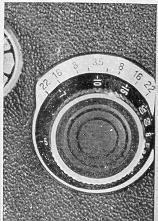 |
At the focusing knob is a scale which will indicate the Depth-of-Field when the camera is focused at various distances. You will notice that an either side of the f 3.5 figure is a similar set of numbers which represent lens apertures. When the camera is fecund on your subject look for the aperture you are using on either side of the scale to determine the Depth-of-Field. Thus, if the camera is focused at 10 feet and the lens aperture is f :8 the Depth-of-Field Area in which all objects are sharp) s from about 8 ft. to 13 ft. |
You can also use the depth-of-field scale to use your
Yashica as a fixed-focus camera. In this case set the infinity mark on the
distance scale opposite the lens aperture being used. If the aperture is f 8 you
will notice that all objects from about 25 feet to infinity will be sharp.
FILTERS
Your Yashica-A accepts sunshades and filters adapter rings in
convenient push-on mounts that readily fasten to the 'taking' lens. A complete
range of filters and supplementary lenses are available in the popular 32 mm
size.
Initially, you will find a yellow filter ideal
for bringing out clouds in landscape pictures and for general uses. As you
become more advanced, you may want to use various filters, such as orange,
green, etc. for different effects. Your camera dealer will give you complete
information.
|
Notice! |
REVIEW:
a. Select your exposure
combination
b. Set the lens opening (aperture)
c.
Set the shutter speed
d. "Cock" the shutter
e. Focus on
the ground glass screen
f. Compose Ion the ground glass or
through the sportsfinder)
g. Take the picture h Advance the film